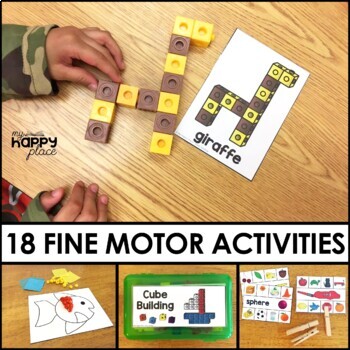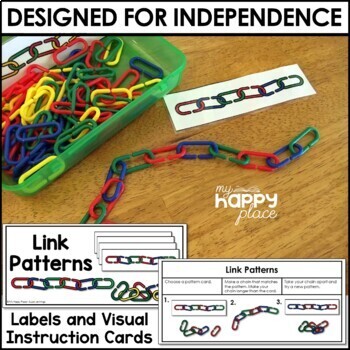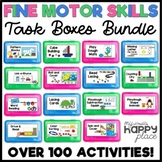Fine Motor Skills Task Boxes - Morning Tubs - Fine Motor Activities
- PDF
What educators are saying
Also included in
- This bundle of over 100 fine motor activities targets the development of fine motor skills in preschool and kindergarten students while also fostering independence and excitement about school. Fine motor skills in young children are a predictor of academic success, but many students begin school stPrice $42.40Original Price $106.75Save $64.35
Description
Are your students struggling with fine motor skills and independence in the classroom? These Fine Motor Task Boxes are the solution to your struggles! Perfect for morning tubs, early finishers, or busy boxes, this set of 18 fine motor activities targets the development of fine motor skills in preschool and kindergarten students while also fostering independence and excitement about school. Designed to be completed independently, these fine motor activities build finger strength, dexterity, and coordination while giving you time to take care of some of the many other tasks that demand your attention each day!
These Fine Motor Skills Task Boxes are part of a bundle.
What You Get:
This set includes ideas and printable materials for 18 fine motor task boxes. Each task is designed to fit into a standard plastic pencil box and includes a printable label, picture directions, and other materials (such as work mats or task cards).
The included fine motor activities are:
Clip Cards (colors and shapes)
Pompom Numbers
Pattern Blocks
Dot Pictures
Cube Building
Link Patterns
Write & Wipe Mazes
Playdough Mats
Lacing Cards
Bead Lacing
Letter Punch Cards
Number Punch Cards
Scissor Practice
Make Something! (cut and glue activity)
Silly Hair Craft (cut and glue activity)
Stencil Tracing
Tissue Paper Pictures
Torn Paper Letters
How to Use These Fine Motor Activities:
Once you get your students started with these task boxes with some initial instructions, they will be up and running and ready for independence! These fine motor task boxes are perfect to grab during any of the times that you need students to be independent, engaged, and productive. Use these simple fine motor activities as morning tubs when students arrive in the classroom (a soft start is a great way to let students gently adjust to the school day) or as early finishers for children who finish their work quickly. These fine motor activities are also useful during center time, indoor recess, or any time students need a quiet break to re-focus.
To prepare these Fine Motor Task Boxes, print and laminate the activity label and instructions as well as the printable activity materials. Attach the activity label to the outside of the box and the illustrated instruction card inside the lid. (You can use Velcro to attach the labels if you want to have the flexibility to easily switch activities throughout the year!) Place all listed materials inside the box. Each activity requires the inclusion of other classroom items such as manipulatives or basic classroom supplies (listed below).
Once assembled, these fine motor activities stack easily on a shelf. Teach your students what procedures you would like them to follow for use and clean up. Some teachers allow students to come into the classroom and quietly select any of the morning tubs, while others prefer a check-in/out system that encourages children to cycle through the activities. Another option is to make a selection of task boxes available at each table and rotate them as the week goes on. This option can cut down on transition time and allow students to quickly choose an early finisher activity.
What Teachers Are Saying:
⭐⭐⭐⭐⭐ "This may be the BEST purchase I've ever made! The activities are colorful, engaging, and purposeful. I assigned a new task box to each student each day. They spent the first 15 minutes of each day doing their task. It was a routine they learned easily and could do independently. I went on to purchase ALL the fine motor task box resources created by 'My Happy Place.'" -Kathleen R.
⭐⭐⭐⭐⭐ "I had to have more hands-on activities for my classroom and had to have them fairly quickly. This resource allowed me to address multiple levels/skills. My students are excited to come in and see what activities I have laid out for them each morning.” -Shannon B.
⭐⭐⭐⭐⭐ "These fine motor tasks bins have been the perfect independent centers for my students to complete while doing small group math lessons. They are easy enough that my kindergarteners do not need much help from me but the perfect amount of work to keep them working for the whole center time. It has also been really important since many students have been struggling with their fine motor skills due to the pandemic. This has been an amazing resource in my kindergarten classroom.” –Anastasia L.
⭐⭐⭐⭐⭐ "My students love these for their morning work! They think they are having fun but really they are making their hands so much stronger for writing and drawing ;)” –Emma W.
Recommended Materials List (not included in purchase):
copy paper, card stock, laminator/film
clothespins (approx. 5)
craft pompoms
child’s tweezers (1)
pattern blocks
¾” circular counters
red, yellow, green, blue, purple
connecting cubes (approx. 30)
math links (plastic chain links)
red, blue, yellow, green
dry erase markers/erasers
playdough (small container)
shoelaces (at least 2)
pony beads
hole punches (2)
child’s scissors (3 pairs)
glue
tag board or one file folder
tissue paper
construction paper
Why are fine motor skills important?
Research shows that well-developed fine motor skills in young children are a predictor of academic success. It makes sense that children with dexterity and hand strength would be more successful in a classroom that requires writing and drawing, but researchers have found that the connection goes beyond that. Through a series of studies using longitudinal data that tracked students from kindergarten through eighth grade, researchers determined that strong fine motor skills in the early years of life help form connections in the brain that lead to greater academic achievement throughout the school years. Unfortunately, advances in technology have led many families away from traditional activities that promote fine motor development. The time that many children spend using computers, tablets, and smartphones is time that they are not spending building, drawing, and manipulating objects in the world around them. Many children are beginning school with a deficit of motor skills, both gross and fine. It is important for schools to give children many opportunities to build those skills.
You may also like:
▶ Geoboards Task Cards
▶ Homework Choice Boards for Kindergarten: Family-Friendly Menus
▶ Early Finisher and Indoor Recess Activity Fun Boxes Bundle
Please see the preview file for more detailed images. If you have any questions, email susan@myhappyplaceteaching.com or use the “Q&A” feature on this page.
Let's keep in touch! Follow my store to be the first to know about sales and new resources.
Thank you for shopping!
Susan Jennings (My Happy Place)
___________________________________
Copyright © My Happy Place Teaching Resources
Permission to copy for single classroom use only.
Please purchase additional licenses if you intend to share this product.






